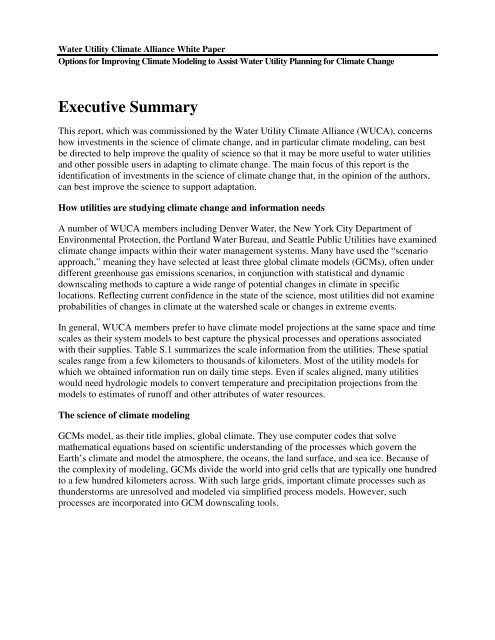Options for Improving Climate Modeling to Assist Water Utility ...
Options for Improving Climate Modeling to Assist Water Utility ...
Options for Improving Climate Modeling to Assist Water Utility ...
Create successful ePaper yourself
Turn your PDF publications into a flip-book with our unique Google optimized e-Paper software.
<strong>Water</strong> <strong>Utility</strong> <strong>Climate</strong> Alliance White Paper<br />
<strong>Options</strong> <strong>for</strong> <strong>Improving</strong> <strong>Climate</strong> <strong>Modeling</strong> <strong>to</strong> <strong>Assist</strong> <strong>Water</strong> <strong>Utility</strong> Planning <strong>for</strong> <strong>Climate</strong> Change<br />
Executive Summary<br />
This report, which was commissioned by the <strong>Water</strong> <strong>Utility</strong> <strong>Climate</strong> Alliance (WUCA), concerns<br />
how investments in the science of climate change, and in particular climate modeling, can best<br />
be directed <strong>to</strong> help improve the quality of science so that it may be more useful <strong>to</strong> water utilities<br />
and other possible users in adapting <strong>to</strong> climate change. The main focus of this report is the<br />
identification of investments in the science of climate change that, in the opinion of the authors,<br />
can best improve the science <strong>to</strong> support adaptation.<br />
How utilities are studying climate change and in<strong>for</strong>mation needs<br />
A number of WUCA members including Denver <strong>Water</strong>, the New York City Department of<br />
Environmental Protection, the Portland <strong>Water</strong> Bureau, and Seattle Public Utilities have examined<br />
climate change impacts within their water management systems. Many have used the “scenario<br />
approach,” meaning they have selected at least three global climate models (GCMs), often under<br />
different greenhouse gas emissions scenarios, in conjunction with statistical and dynamic<br />
downscaling methods <strong>to</strong> capture a wide range of potential changes in climate in specific<br />
locations. Reflecting current confidence in the state of the science, most utilities did not examine<br />
probabilities of changes in climate at the watershed scale or changes in extreme events.<br />
In general, WUCA members prefer <strong>to</strong> have climate model projections at the same space and time<br />
scales as their system models <strong>to</strong> best capture the physical processes and operations associated<br />
with their supplies. Table S.1 summarizes the scale in<strong>for</strong>mation from the utilities. These spatial<br />
scales range from a few kilometers <strong>to</strong> thousands of kilometers. Most of the utility models <strong>for</strong><br />
which we obtained in<strong>for</strong>mation run on daily time steps. Even if scales aligned, many utilities<br />
would need hydrologic models <strong>to</strong> convert temperature and precipitation projections from the<br />
models <strong>to</strong> estimates of runoff and other attributes of water resources.<br />
The science of climate modeling<br />
GCMs model, as their title implies, global climate. They use computer codes that solve<br />
mathematical equations based on scientific understanding of the processes which govern the<br />
Earth’s climate and model the atmosphere, the oceans, the land surface, and sea ice. Because of<br />
the complexity of modeling, GCMs divide the world in<strong>to</strong> grid cells that are typically one hundred<br />
<strong>to</strong> a few hundred kilometers across. With such large grids, important climate processes such as<br />
thunders<strong>to</strong>rms are unresolved and modeled via simplified process models. However, such<br />
processes are incorporated in<strong>to</strong> GCM downscaling <strong>to</strong>ols.

















